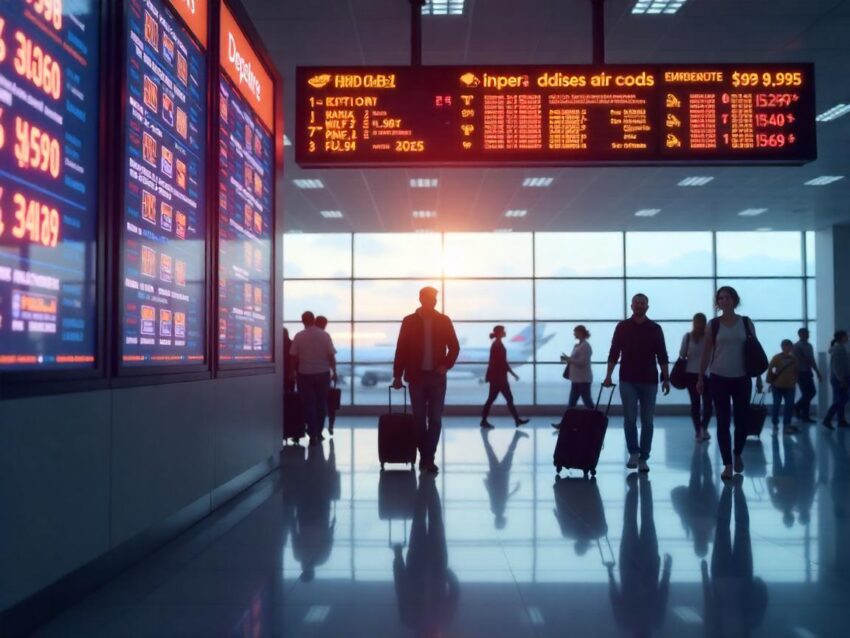
FCM Report Reveals US Domestic Airfares Defy Soaring Inflation, Offering Unexpected Relief for Travelers Amid Historic Cost-of-Living Crisis and Shaking Up Airline Revenue Strategies

American travelers have been bracing for the worst. Across supermarket aisles and gas stations, prices keep climbing. Everyday items like eggs, bread, and milk have surged so dramatically that many families feel squeezed to the brink. Yet, in a twist few saw coming, the cost of flying across the United States remains surprisingly stable.
That’s the compelling revelation from a new study released by FCM Consulting, the analytics arm of global travel management powerhouse FCM Travel. At a time when inflation seems relentless, the price of domestic airline tickets has increased at less than half the rate of broader consumer costs since 2019.
This isn’t just a curious statistic—it’s a development reshaping how travelers plan trips, how airlines design pricing strategies, and how the entire travel sector navigates a volatile economy.
It’s a rare silver lining amid the storm clouds of inflation. And it’s sparking big conversations about where U.S. travel goes next.
Inflation’s Relentless Climb Hits Everyday Americans
Between 2019 and 2025, the U.S. Consumer Price Index (CPI) jumped by 26%. For millions of households, this figure is more than an economic abstraction—it’s a relentless reality.
In 2019, a market basket of goods and services worth $1.00 costs roughly $1.26 today. That extra quarter on every dollar eats away at family budgets, fueling anxiety and reshaping spending habits.
The everyday items driving this surge paint a grim picture. A dozen eggs have skyrocketed by 80%. A loaf of bread now costs 44.6% more. Milk is up 32.2%. Even a gallon of gas, though lower than its record highs, has still climbed 21.9%.
Families are cutting back on restaurants, skipping big-ticket purchases, and looking nervously at bank balances. Yet somehow, flying across the country remains one of the few bright spots in American spending.
Domestic Airfares Stay Surprisingly Grounded
FCM’s data reveals a remarkable contrast.
Since 2019, economy-class fares on domestic U.S. flights have risen by just 10.7%. Business-class fares have barely budged at all, inching up only 1.5%. That’s less than half the pace of general inflation.
For travelers who feared airfare would spiral out of reach, these numbers bring a mix of relief and confusion. How can flying remain relatively affordable while the price of eggs has nearly doubled?
The answer lies in fierce competition, evolving airline economics, and travelers’ shifting priorities.
Airlines Under Pressure to Compete
The U.S. airline industry has spent the past six years in a state of relentless transformation. From pandemic lockdowns to skyrocketing fuel costs, carriers have faced one crisis after another. Yet one thing hasn’t changed: the brutal fight for passengers.
Competition between major airlines remains intense. Carriers know that domestic travelers are quick to compare fares. Even modest price hikes can send business to rivals.
Rather than risk losing customers by raising base ticket prices dramatically, airlines have chosen to keep fares steady—even as their own costs climb. This strategic restraint helps maintain passenger volumes and ensures planes fly full.
It’s a delicate balance. Airlines still have to make money. So instead of inflating ticket prices, they’ve turned to creative revenue streams to shore up their bottom lines.
The Rise of Ancillary Revenue
This is where the story of stable airfares gets more complicated.
Airlines haven’t simply swallowed rising costs out of generosity. Instead, they’ve shifted the economic model of flying.
Rather than relying solely on ticket sales, carriers are increasingly leaning on ancillary revenue—money earned through extras like baggage fees, seat selection charges, priority boarding, onboard food and drink, Wi-Fi access, and more.
For travelers, this means the base price of a ticket may stay low, but the total cost of a trip can add up quickly if they opt for convenience and comfort.
Yet many passengers still appreciate the flexibility. Those traveling light can keep costs minimal. Others willing to pay for extra perks effectively subsidize affordable fares for everyone else.
Loyalty Programs Take Center Stage
Airlines are also turning to loyalty programs as crucial revenue tools.
Instead of blanket fare hikes, carriers are using data to identify and reward high-value travelers. Elite frequent flyers receive perks like free upgrades, checked bags, and bonus miles. Meanwhile, occasional travelers face more fees for the same benefits.
This segmented approach allows airlines to maximize revenue without alienating price-sensitive passengers. It’s a strategy that keeps planes full and helps carriers remain profitable—even when ticket prices barely move.
Travelers Catch a Rare Break
For American consumers battered by rising living costs, the news from FCM’s report feels like a rare break.
It means domestic getaways remain within reach for millions of people. Whether it’s a family visiting relatives across the country, a business traveler heading to a client meeting, or a spontaneous trip to explore a new city, domestic flying continues to be a viable option.
At a time when gas prices, grocery bills, and housing costs all gnaw at household budgets, steady airfares offer a small but meaningful bit of economic breathing room.
The Psychological Impact of Stable Fares
Beyond economics, there’s a powerful psychological dimension at play.
Travel represents freedom. It’s an escape from routine and a chance to create memories. Knowing that airfares remain relatively stable helps preserve a sense of possibility, even as inflation reshapes daily life.
For many, the ability to plan a trip without fearing catastrophic costs is deeply reassuring. It’s proof that some joys remain accessible, no matter how turbulent the economy becomes.
Challenges Still Linger for Airlines
Despite the positive headlines, airlines aren’t in the clear.
Fuel prices remain volatile. Labor costs continue to rise. Global uncertainties—from geopolitical tensions to supply chain snags—threaten airline operations and profitability.
Carriers walk a tightrope, balancing affordability with sustainability. If economic pressures intensify, airlines may eventually face no choice but to raise fares. For now, however, competitive dynamics and innovative revenue strategies are keeping prices largely in check.
Impact on the Broader Travel Industry
The implications of stable domestic airfares ripple across the entire travel sector.
Hotels, car rental companies, and attractions all benefit when travelers feel confident enough to book flights. Lower fares help sustain tourism demand, keeping jobs secure in cities that rely heavily on visitor spending.
In destinations like New York, Los Angeles, Orlando, and Las Vegas, the connection between airfare affordability and economic vitality is impossible to ignore. FCM’s report suggests that stable domestic flight costs could be a crucial pillar supporting travel industry recovery in the years ahead.
A Story of Resilience and Innovation
FCM’s findings tell a story of resilience and innovation.
Even as inflation claws into every corner of American life, airlines have found ways to hold the line on domestic fares. It’s a testament to the industry’s adaptability and to the power of competition in protecting consumers.
For travelers, it’s a reminder that while the world may feel more expensive than ever, adventure is still within reach. And that’s a story worth celebrating.
Looking Ahead
The next few years will be critical. Will domestic airfares continue to defy inflation? Or will economic pressures eventually force airlines to raise prices significantly?
Travelers should watch the skies carefully. For now, though, the outlook remains unexpectedly positive. In a world where everything else costs more, the chance to explore America by air remains an affordable dream for millions.
And in an era defined by uncertainty, that’s a piece of good news the travel industry—and American travelers—desperately need.
The post FCM Report Reveals US Domestic Airfares Defy Soaring Inflation, Offering Unexpected Relief for Travelers Amid Historic Cost-of-Living Crisis and Shaking Up Airline Revenue Strategies appeared first on Travel And Tour World.
FCM Report Reveals US Domestic Airfares Defy Soaring Inflation, Offering Unexpected Relief for Travelers Amid Historic Cost-of-Living Crisis and Shaking Up Airline Revenue Strategies
| Divisions of Shy Paris Entertainment | ||||
|---|---|---|---|---|
| Shyparis Entertainment | Shy Paris Bookings | Linkz Radio | Klublinks | Shy Paris |
Shy Paris Bookings is a Division of
❤Shy Paris Entertainment ||||| International Spectacular Events, Stellar Event Planning and Management, & Celebrity Booking Agency. Please contact us as we can provide you with both international and/or local renowned full service event planning and management, & celebrity bookings at shyparisentertainment@gmail.com or
CONTACT: Email: shyparisentertainment@gmail.com
Facebook: ShyParis Youtube: @Shyparis Twitter: @Shyparisent Instagram: shyparisentertainment Whatsapp: 1-437-259-3399
✶✶✶✶✶✶✶✶✶✶✶✶✶✶✶✶✶✶✶✶✶✶✶✶✶✶✶✶✶✶✶✶✶✶✶✶✶✶✶✶✶✶✶✶✶✶✶✶✶✶
SHY PARIS ENTERTAINMENT COMPANIES
✅ ShyParisentertainment.co – https://shyparisentertainment.co
✅ Shyparisbookings.com – https://shyparisbookings.com
✅ Linkzradio.com – https://linkzradio.com
✅ Klublinks.com – https://klublinks.com
✅ Shypariswebdesign.com – https://shypariswebdesign.com
✅ ❤️ Shyparis – htttps://shyparis.com❤️






